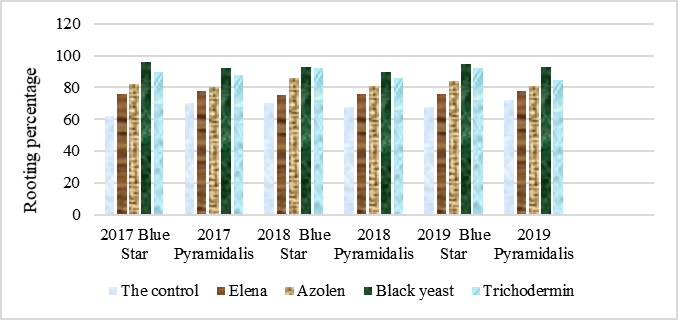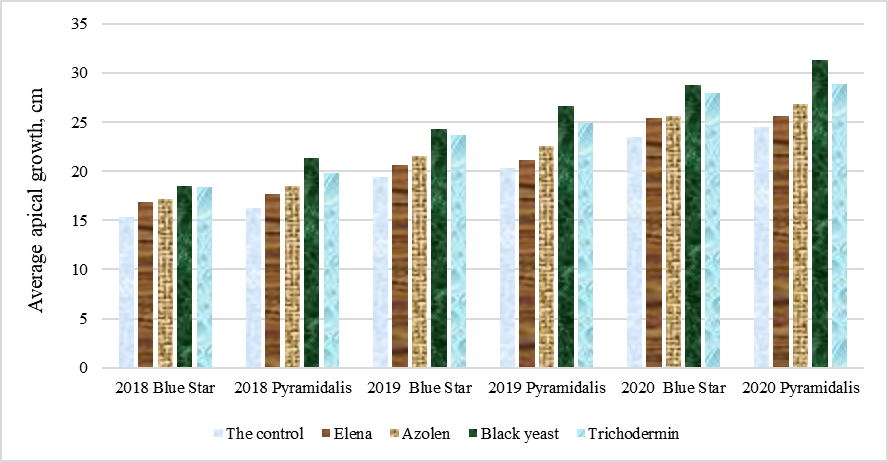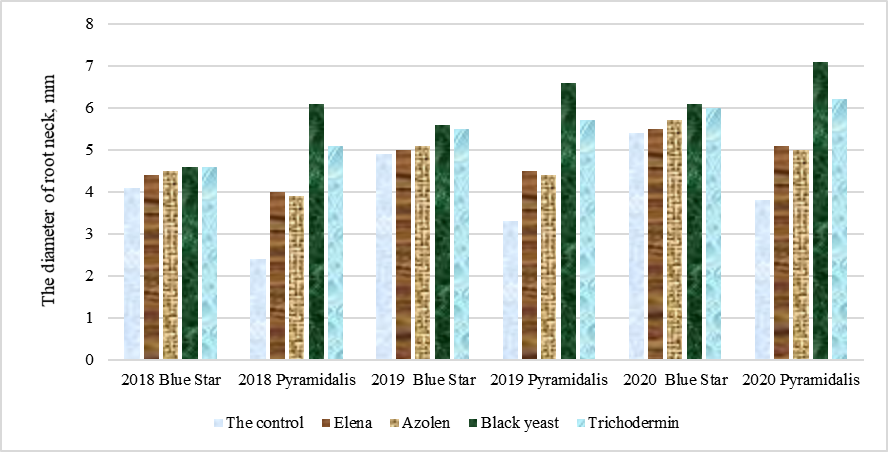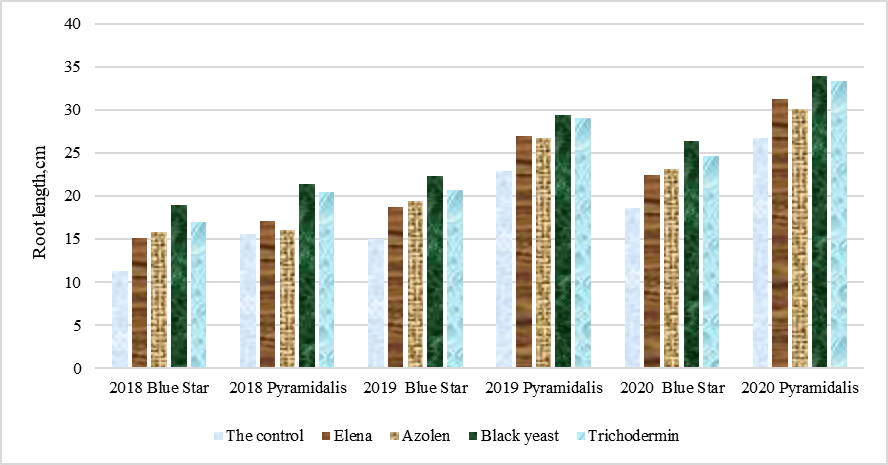Abstract
Experimental data for 2017-2020 on the cultivation of introduced species of junipers are presented and the effect of microbiological preparations on their vegetative reproduction is analyzed. The implementation of the technology of growing cuttings seedlings was carried out in open ground with the use of environmentally friendly preparations: Elena, Azolen, Trichodermin, Black yeast. Despite the different mechanisms of action of the studied preparations, they all had a positive effect on the rooting process of green cuttings and the growth of cuttings. Azolen acts through fungicidal, growth-stimulating properties and nitrogen-fixing ability. Elena increases the percentage of rooted cuttings due to the formation of antibiotics, the decomposition of inorganic phosphates and their transformation into a form available to plants. Trichodermin enhances root growth in cuttings through antibiotic-induced protective properties, plant growth stimulation, fertilization and soil formation. Black yeast and its waste products provide plants with hormones, stimulate more powerful development of the root system, inhibit the development of pathogenic microflora, and optimize the processes of mineral nutrition of plants. Black yeast and Trichodermin have consistently been the best preparations for three years of research that increase the development parameters of cuttings: root development, an increase in the diameter of the root neck and growth. Common juniper is subject to a stronger effect of the studied environmentally friendly preparations, which is manifested in a faster growth and development. The outstripping development of cuttings of the vertical type of juniper in comparison with the horizontal species was established.
Keywords: Apical growth, diameter of the root neck, environmentally friendly preparations, green cuttings, rooting, root system
Introduction
Cutting technology is given a leading place in the propagation of decorative deciduous, coniferous trees and shrubs. In this technology, considerable attention is paid to increasing the reproduction rate and safety of cuttings (Gorb & Barayshchuk, 2019; Severino et al., 2011; Tetsumura et al., 2017).
Problem Statement
The inclusion of growth stimulants in the technological process is the most well-known, applied and effective technique that stimulates the processes of root regeneration during vegetative propagation of plants (Balestri et al., 2012; Kanmegne et al., 2017; Sağlam et al., 2014; Small & Degenhardt, 2018; Venkatachalam et al., 2015). In the technology of cuttings, synthetic growth regulators with auxin activity (β - BCI, heteroauxin, etc.) are most often used, which belong to moderately toxic compounds. Therefore, a promising direction is the search for effective environmentally friendly preparations that would be as effective as synthetic auxins and would have a positive effect on the adaptive properties of rooted plants. The microbiological method of protecting and stimulating plants was originally developed in the field of agriculture, but is now applied to forest and ornamental tree species (Gorb & Barayshchuk, 2019; Lekontseva et al., 2019; Pacholczak et al., 2017). The basis of microbiological preparations are producer strains and their metabolic products: enzymes, antibiotics, siderophores, hormones. These biologically active substances form the complexity of the action of microbiological preparations. Thus, the antibiotic activity provides the fungicidal action of the preparations, which is important when the soil moisture changes during the cultivation of junipers (Donaid et al., 2020). Optimal mineral nutrition is important for junipers (Pers-Kamczyc et al., 2020). The introduction of elements of mineral nutrition contributes to an increase in the growth in height and diameter, affects the growth of roots and shoots of trees (Olaetxea et al., 2018). Microbiological preparations based on yeast not only increase plant immunity and suppress the development of pathogenic microorganisms, but also contain nutrients for plants: nitrogen, phosphorus, potassium, which improve the supply of plants with mineral nutrition (Fernandez-San Millan et al., 2020; Fu et al., 2016; Gorb & Barayshchuk, 2019).
Research Questions
The use of environmentally friendly preparations contributes to an increase in soil fertility, an increase in microbiological soil activity and, in general, contributes to the expansion of organic farming.
Feasibility of using microbiological preparations for rooting green cuttings of introduced species of junipers.
Feasibility of using the preparations: Black yeast, Trichodermin, Elena, Azolen due to their influence on the growth and development parameters of juniper cuttings: growth, diameter of the root neck, development of the root system.
Purpose of the Study
In order to establish the effectiveness of biological preparations Elena, Azolene, Black yeast and Trichodermin as stimulators of root formation for green cuttings, an experiment was laid in 2017-2019 to study the effect of preparations on the rooting of green cuttings and the development of cuttings of horizontal and vertical junipers: blue scaly juniper (") and common juniper (").
Research Methods
The research was carried out on the basis of the regional dendrological garden named after G.I. Hense. Green cuttings were planted in the ground the next day after treatment with preparations. As a substrate, a mixture of sod land with peat was used in accordance with 1: 1. The preparations were used in accordance with the recommendations of the manufacturer - the biological laboratory of the Federal State Institution "Omsk Reference Center of Rosselkhoznadzor". Until the roots appeared, spraying was carried out from a spray gun 2-3 times a day. Cuttings were planted according to the 5x10 cm scheme, 100 cuttings in three repetitions. The distance between the rows when planting cuttings in the experimental variants was 10 cm, the distance between the cuttings in a row was 5 cm. Such a planting scheme promotes good ventilation, lack of shading, which helps to prevent rotting of cuttings. The rooting dynamics were observed from the day of the experiment with an interval of 7 ... 10 days. One-year and two-year-old cuttings in June were treated with preparations by spraying.
Findings
The rooting data allow us to evaluate the effectiveness of the action of the preparations. The use of microbiological preparations Black yeast and Trichodermin contributed to the greatest increase in the number of rooted cuttings in all years of research. Elena and Azolene preparations were effective in the rooting process compared to the control (Figure 1).

In the control variant, the rooting rate of cuttings varied within 60-70%. When using Elena's preparation, rooting of cuttings increased to 76% () and 77% (J). Treatment of cuttings with Azolen promoted an increase in rooting by 11-17% in both types of junipers compared to the control. With the use of Trichodermin, root formation increased from 16% ( to 24% (). The use of the Black Yeast preparation made it possible to obtain 95% of rooting in horizontal juniper and 92% in vertical juniper, which was an increase of 28% and 22%, respectively, in comparison with the control (Fig. 1). The analysis of variance carried out allows us to conclude that all the studied preparations contributed to an increase in the rooting of green cuttings. At the same time, the horizontal blue juniper rooted more successfully than the vertical species under the influence of the preparations Azolen, Black yeast, Trichodermin.
The largest increase in blue juniper under the influence of the microbiological preparation Black Yeast for three years was 18.5, 24.3, 28.8 cm, and in pyramidal juniper, respectively: 21.3 cm, 26.6, 31.3 cm (Figure 2). Analysis of variance confirms that the vertical view of the juniper grows more intensively than the horizontal one under the influence of the Black Yeast preparation.

The diameter of the root neck of blue juniper in the first year of cultivation ranged from 4.4 to 4.6 mm under the influence of the studied preparations, in the second year: from 5 to 5.6 mm, in the third year: from 5.5 to 6.1 mm. Under the influence of biological preparations, the diameter of the root neck of pyramidal juniper increased from 3.9 to 6.1 mm in the first year, from 4.4 to 6.6 mm in the second and from 5 to 7.1 in the third year. Black yeast and Trichodermin should be recognized as more effective preparations affecting the increase in the diameter of the root neck (Figure 3). It is statistically substantiated that a successful increase in the diameter of the root neck occurs in a vertical pyramidal juniper under the influence of the Black Yeast preparation.

According to the data of the first year, the length of the root system, formed under the influence of the preparations, of blue juniper ranged from 15.1 to 19 cm, in the second year: from 18.7 to 22.3 cm, in the third year: from 22.5 to 26.4 cm. In the vertical pyramidal juniper, the root system developed more intensively, which is confirmed by analysis of variance. In the first year of cultivation, the length of the roots of cuttings grown under the influence of preparations ranged from 16.1 to 21.4 cm, in the second year – from 26 to 29.4 cm, in the third year – 30.1 to 33.9 cm (Figure 4).

Cuttings of an upright species of formed a more powerful root system. Black yeast and Trichodermin were effective formulations for promoting root growth.
Conclusion
Based on the results of the studies, it can be concluded that the best preparations that affect the formation of cuttings with the highest growth and development rates are Black Yeast and Trichodermin. The complex mechanism of action of these preparations allows you to increase immunity, exhibit antibiotic activity and optimize the mineral nutrition of plants. In our experiments, the vertical juniper Pyramidalis had the maximum growth and development characteristics under the influence of the studied microbiological preparations. The high decorativeness of both species of introduced junipers makes them desirable for growing in recreational areas. Research results make it possible to recommend these species for expanding the range used in urban landscaping.
References
Balestri, E., Vallerini, F., Castelli, A., & Lardicci, C. (2012). Application of plant growth regulators, a simple technique for improving the establishment success of plant cuttings in coastal dune restoration. Estuarine, Coastal and Shelf Science, 99, 74-84.
Donaid, F., Green, S., Searle, K., Cunniffe, N. J., & Purse, B. V. (2020). Small scale variability in soil moisture drives infection of vulnerable juniper populations by invasive forest pathogen. Forest Ecology and Management, 473, 118324.
Fernandez-San Millan, A., Farran, I., Larraya, L., Ancin, M., Arregui, L. M., & Veramendi, J. (2020). Plant growth-promoting traits of yeasts isolated from Spanish vineyards: benefits for seedling development. Microbiological Research, 237, 126480.
Fu, S. F., Sun, P. F., Lu, H. Y., Wei, J. Y., Xiao, H. S., Fang, W. T., Cheng, B. Y., & Chou, J. Y. (2016). Plant growth-promoting traits of yeasts isolated from the phyllosphere and rhizosphere of Drosera spatulata Lab. Fungal biology, 120(3), 433-448.
Gorb, Е. А., & Barayshchuk, G. V. (2019). Evaluation of microbiological preparations effect on introduced species of trees. The Fifth Technological Order: Prospects for the Development and Modernization of the Russian Agro-Industrial Sector, TFTS (pp. 119-123). Atlantis Press.
Kanmegne, G., Mbouobda, H. D., Kamtat, G. F., & Omokolo, D. N. (2017). Interaction of stockplants shading and exogenous auxin on the propagation of Cola anomala K. Schum (Malvaceae) by cuttings. South African Journal of Botany, 112, 246-252.
Lekontseva, T., Fedorov, A., & Khudyakova, A. (2019). Biotechnology as a heart of innovation in nursery management of ornamental plants. In International Scientific and Practical Conference “Digital agriculture-development strategy” (ISPC 2019) (pp. 285-288). Atlantis Press.
Olaetxea, M., De Hita, D., Garcia, C. A., Fuentes, M., Baigorri, R., Mora, V., Garnica, M., Urrutia, O., Erro, J., Zamarreno, A. M., Berbara, R. L., & Garcia-Mina, J. M. (2018). Hypothetical framework integrating the main mechanisms involved in the promoting action of rhizospheric humic substances on plant root-and shoot-growth. Applied Soil Ecology, 123, 521-537.
Pacholczak, A., Jędrzejuk, A., & Sobczak, M. (2017). Shading and natural rooting biostimulator enhance potential for vegetative propagation of dogwood plants (Cornus alba L.) via stem cuttings. South African Journal of Botany, 109, 34-41.
Pers-Kamczyc, E., Tyrała-Wierucka, Ż., Rabska, M., Wrońska-Pilarek, D., & Kamczyc, J. (2020). The higher availability of nutrients increases the production but decreases the quality of pollen grains in Juniperus communis L. Journal of plant physiology, 248, 153156.
Sağlam, A. C., Yaver, S., Başer, İ., & Cinkiliç, L. (2014). The effects of different hormones and their doses on rooting of stem cuttings in Anatolian sage (Salvia fruticosa mill.). APCBEE procedia, 8, 348-353.
Severino, L. S., Lima, R. L., Lucena, A. M., Freire, M. A., Sampaio, L. R., Veras, R. P., Medeiros Katty A. A. L., Sofiatti, V., & Arriel, N. H. (2011). Propagation by stem cuttings and root system structure of Jatropha curcas. Biomass and Bioenergy, 35(7), 3160-3166.
Small, C. C., & Degenhardt, D. (2018). Plant growth regulators for enhancing revegetation success in reclamation: A review. Ecological Engineering, 118, 43-51.
Tetsumura, T., Ishimura, S., Honsho, C., & Chijiwa, H. (2017). Improved rooting of softwood cuttings of dwarfing rootstock for persimmon under fog irrigation. Scientia Horticulturae, 224, 150-155.
Venkatachalam, P., Kalaiarasi, K., & Sreeramanan, S. (2015). Influence of plant growth regulators (PGRs) and various additives on in vitro plant propagation of Bambusa arundinacea (Retz.) Wild: A recalcitrant bamboo species. Journal of Genetic Engineering and Biotechnology, 13(2), 193-200.
Copyright information

This work is licensed under a Creative Commons Attribution-NonCommercial-NoDerivatives 4.0 International License.
About this article
Publication Date
01 July 2021
Article Doi
eBook ISBN
978-1-80296-112-6
Publisher
European Publisher
Volume
113
Print ISBN (optional)
-
Edition Number
1st Edition
Pages
1-944
Subjects
Land economy, land planning, rural development, resource management, real estates, agricultural policies
Cite this article as:
Gorb, E., & Barayshchuk, G. (2021). Greening Coniferous Breeding Technology For Urban Landscaping. In D. S. Nardin, O. V. Stepanova, & V. V. Kuznetsova (Eds.), Land Economy and Rural Studies Essentials, vol 113. European Proceedings of Social and Behavioural Sciences (pp. 156-162). European Publisher. https://doi.org/10.15405/epsbs.2021.07.19

